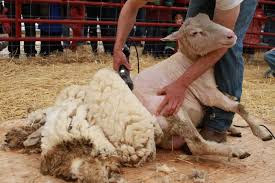"What Is Wool Yarn ?"
By Sara Sach of Posh Pooch Designs
I have seen a lot of talk about Wool lately,
And as a Crafter, a Crocheter and a knitter,
I decided to find out for myself
How Wool Yarn is made.
Here is Video from
International Wool and Textile organization -
Video LINK
Let's Start At The Very Beginning And Answer
Some Questions:
1. What Is Wool?
According to the Dictionary -
"The fine soft curly or wavy hair forming the coat of a sheep, goat, or similar animal, especially when shorn (shaved) and prepared for use in making cloth or yarn."
So basically, it is the hair of a Sheep.
That "hair" is called Fleece.
"The Merino Sheep are a historically relevant and economically influential breed for their much prized wool."
2. How Is The "Fleece" Collected?
According to Wikipedia
"Sheep shearing is the process by which the woollen fleece of a sheep
is cut off. The person who removes the sheep's wool is called a shearer.
Typically each adult sheep is shorn once each year (a sheep may be said
to have been "shorn" or "sheared", depending upon dialect). The annual
shearing most often occurs in a shearing shed, a facility especially
designed to process often hundreds and sometimes more
than 3,000 sheep per day."
So Basically, the sheep get a hair cute, kind of like when a man shaves his beard.
And does not hurt the sheep any more then it hurts you to get your hair cut.
And does not hurt the sheep any more then it hurts you to get your hair cut.
This is very important for the health and safety of the sheep. LINK
"As long as there are sheep, shearing must be practiced for the health
and hygiene of each individual animal.
Unlike other animals, most sheep are unable to shed. If a sheep goes too long without being shorn, a number of problems occur.The excess wool impedes the ability of sheep to regulate their body temperatures. This can cause sheep to become overheated and die.Urine, feces and other materials become trapped in the wool, attracting flies, maggots and other pests. This causes irritation, infections and endangers the health of the animal.Sheep with large amounts of wool can become immobilized by physical obstacles in their path and are more susceptible to predator attacks.
3. How Is Wool Made Into Yarn?
Here is a great Link by Blackberry Ridge Woolen Mill - LINK
After the wool is collected there is
Washing, sorting, picking, combing, and carding,
then the wool is make into thick strips called pencil roving.
It's these roving strips that are spun into beautiful Wool yarns.
Sometime it's spun into pure wool, sometime the wool is spun and mixed
with other fibers like alpaca, bamboo, cotton and even acrylic yarns.
To be honest there is literally 1000s of animal, plant and synthetic yarns
that can be spun together with wool.
4. How Is The Wool Dyed?
There are 2 ways of Dying the Wool,
"If the dyeing occurs after the wool is washed then it is referred to as
stock dyed wool. If the wool is dyed after it is spun into yarn then
it is referred to as yarn dyed. "
If the Wool is being spun or mixed with other Fibers it is usually
dyed before spinning them together.
As Different fibers take dye in different ways.
There are also many different types of dye such as vegetable dyes
For more info on Dyeing Wool see this LINK
I dyed this Wool with Koolaide
It was fun but messy.
Here is what I did - LINK
I know I have only touched the surface of answering the question
"What is Wool Yarn?".
And I know there are those who are unkind to animals,
but that is not the norm. The Wool industry is a fabulous and needed
industry, for yarn, thread, for fabrics, and many other uses.
We must correctly educate our selves and others.
There is nothing better to me, then soft merino wool to work
and to create with.
Remember - these are only my opinions,
you need to form your own.








No comments:
Post a Comment